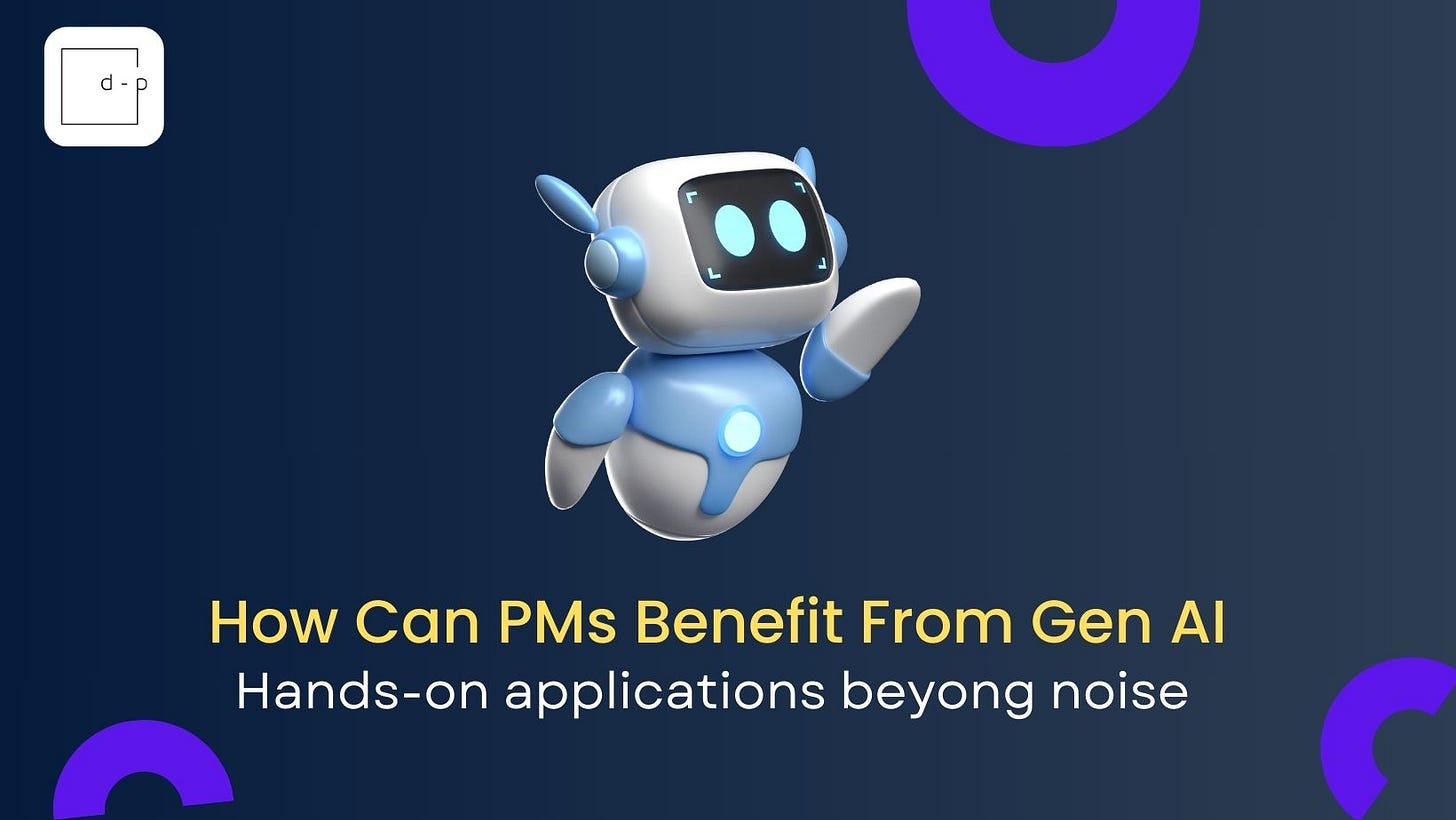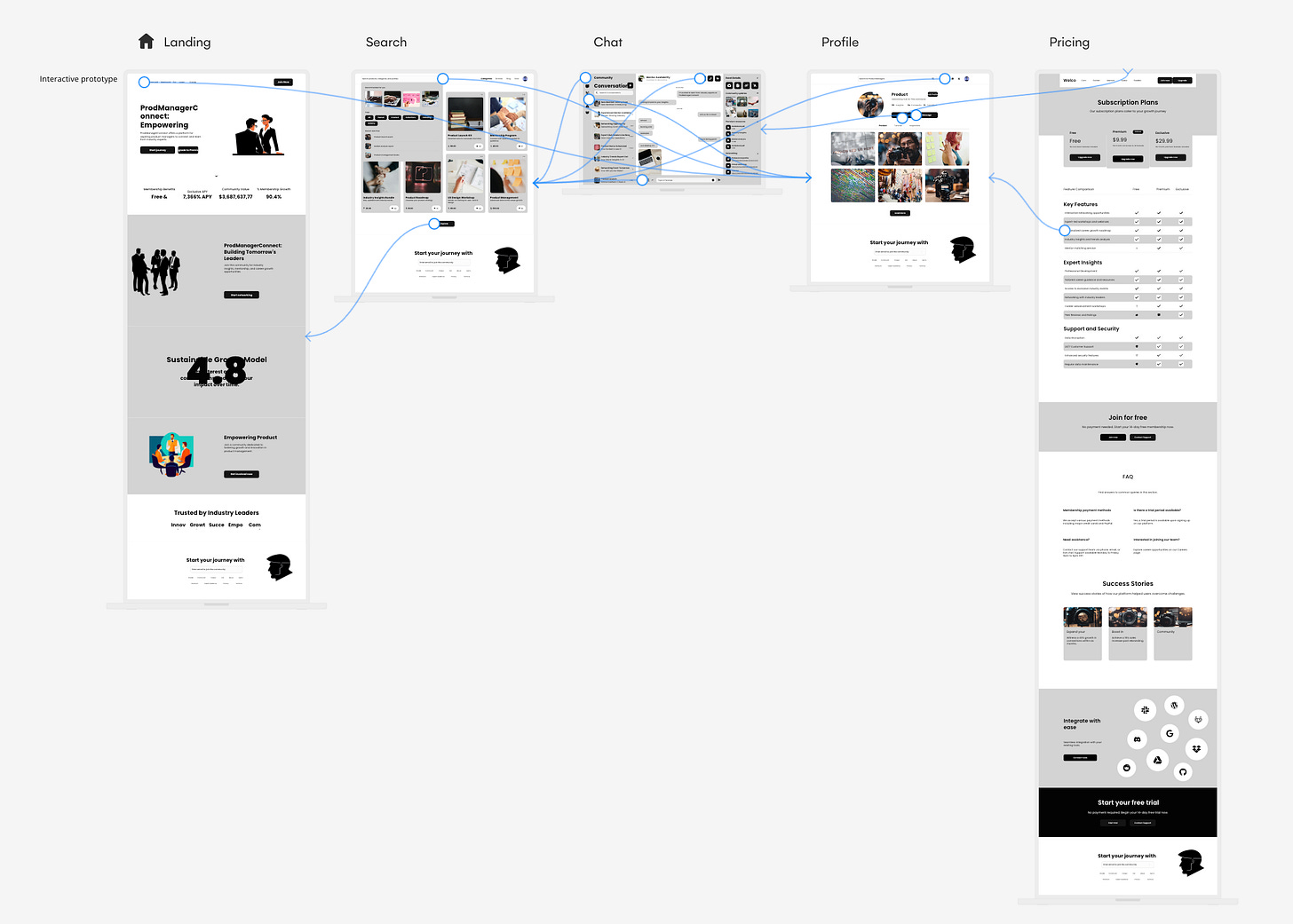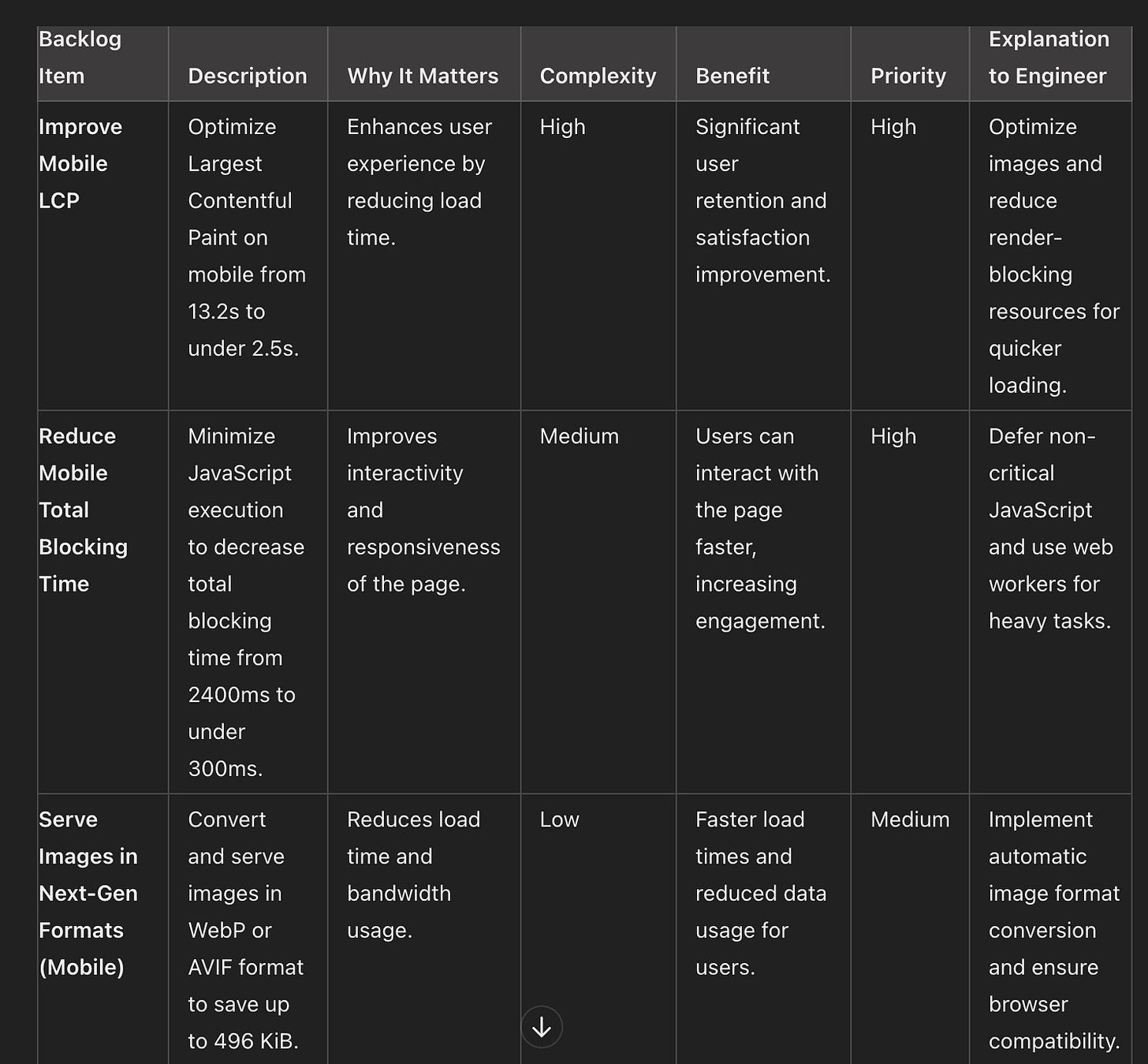How PMs Can Benefit from Generative AI Instead of Being Replaced by It
Announcement: I'm opening a new cohort for Product Discovery Done Right, which now incorporates AI. Check it out. You can expect to learn applicable techniques combined with AI, preparing you for a six-figure salary. Warning: limited seats.
AI accelerated the pace over the last two years, and it doesn’t seem to slow down any time soon. Here are a few amazing things PMs can do with it:
Create an interactive prototype in less than a minute
Synthesize customer interviews in a few seconds
Define solid product experiments for your assumptions faster than you think
Get critics on your work from multiple perspectives without talking to anyone
Create authentic images with simple prompts
Given all the progress we observe, will AI make PMs obsolete? I continuously hear this question, but I’m betting that great PMs will become even better.
AI is the co-pilot able to amplify PM’s potential, who acts as the pilot.
Let’s take this post to clarify how PMs can benefit from AI. We will cover:
What’s the impact of AI on product people?
Using AI as a co-pilot
Understanding the power of prompts
Generative AI Tools. Accelerating Designs, maximizing insights, summarizing content, bringing new perspectives
What should product people pay particular attention to?
What’s the Impact of AI on Product People?
It’s impossible to deny how AI is shaping our lives. For those who fail to understand its potential, becoming obsolete is a probable outcome. Does it mean PMs should use AI for everything? Not that fast.
First, AI is becoming a loaded term. There’s more to it than you can imagine. AI has multiple layers, and you should understand them so you can make a better use of it.
I believe AI will boost our potential, especially for those mastering how to use it. Here are a few things you will be able to do:
Create designs without interacting with a product designer
Write compelling copy without hiring a copywriter
Crafting outstanding presentations with minimum effort
Gathering insights from considerable datasets in seconds instead of hours
That’s possible through different aspects of AI; the following images show an overview.

Using AI as a Co-Pilot
Shyvee Shi, author of “Reimagined: Build Products with Generative AI,” emphasizes the importance of using AI as the co-pilot, not the pilot. What does that mean in practice?
You’re the driver, not the passenger.
AI will help you solve challenges you face faster than you’d otherwise do it alone. Yet, that implies a few critical things:
Expertise: You’re the expert in your area, so you should use your knowledge to advance and accelerate.
Questions: Knowing which questions to ask and how to ask them will considerably impact the quality of the answers.
Decision-Making: As the driver, you need to call the shots, know where to go, and choose where not to go.
Problem Framing: It’s fundamental how you provide context when using AI. The more precise you frame the problem, the more trustworthy the outcome will be.
Being the driver means you know your field. You could get great results, though that may take some time. AI can shorten that time when used correctly. However, it may distract you when misused.
I discussed this topic with Shyvee on a podcast; listen to it to learn more.
How PMs Can Best Use AI
A few weeks ago, I had an insightful conversation with Shyvee about how PMs can best use AI. This talk is a goldmine for anyone looking to leverage AI's potential in their work. Shyvee is a product lead on LinkedIn and co-author of Reimagined: Building Products with Generative AI
Understanding the Power of Prompts
One critical skill for product people is communication, of which writing is a considerable part. When you write well, you can express your thoughts concisely and consistently. Such skills are becoming more relevant with generative AI, as prompting is at its core.
Knowing how to use prompts shapes the outcome you can get. Let me give you a few hints on what a good prompt should consist of:
Desired expertise: Define how you want AI to behave, e.g., Product Coach, Agile Coach, UX Designer
Context: Elaborate on the context as straightforward as you can
Task(s): Define the tasks you want AI to perform for you
Output format: Clarify how you want the results to be presented, e.g., table, bullet points, etc
Level of detail: How detailed should that be? You can use a few tricks, such as “Explain it to a five-year-old.” “Explain it to a software engineer.” “Explain it to a 50 year old.”
Now, let’s look at a few examples of good and bad. When I wrote my book, I created a survey to learn what people struggled. Let’s see what ChatGPT could do for us.
First, I used the following prompt:
“Analyze the attached file and give me tips on what to write about.”
The prompt is weak because it fails to provide enough details to get a valuable answer. It’s no mystery why the answer fell flat. See the following image.
Now, it’s strengthen the prompt.
”Act as an experienced author in the field of digital product management. Given the answers from the attached file, I want you to:
1. Identify three strong patterns that readers long to understand
2. For each pattern, define a perspective to write from, points to pay attention to, opportunities that would attract readers
3. Present the results in a table”
With this prompt, the answer is more appealing, clarifying what to write about:
Generative AI Tools
Great tools will upgrade the user, not its features. Let me give you a few examples:
Grammarly makes me a better writer
Canva transforms me into a better presenter
Miro enriches my facilitation skills
I used the above tools before the AI hype. These tools stand out because they start with the users’ jobs and use AI to make it easier to achieve desired results.
You may wonder what’s generative AI. Let me clarify that to you.
Generative AI is the type of artificial intelligence able to autonomously create outputs like text, images, videos, and other artifacts. Given the proper context, the application can produce the desired results. When done right, this can be a game-changer.
Let me give you three examples of what you can do:
1. Creating Designs Without Product Designers
Uizard.io, recently acquired by Miro, empowers people to supercharge how they create designs. Here’s an example.
I used a prompt to create a platform for product managers to build community.
Crafting an interactive prototype took roughly one minute, which went from zero to something you could iterate on. I wouldn’t call the result final, but it’s a place to start and make it better.
For me, Uizard.IO is used to accelerate early-stage idea testing.
2. Writing Product Briefs from Customer Interviews
Let’s take an example from one of my cohorts, Product Discovery Done Right. During one exercise, I asked participants to practice interviews and collect what they had learned. After that, they need to consolidate the key points. It generally takes 10-15 minutes, which is something that AI can get done (better than us) in less than a minute.
Miro recently added built-in AI functionality to the intelligent canvas; one feature enables users to synthesize research or write product briefs quickly.
I used the “Product Brief” functionality and got the following result in about 45 seconds. I found it quite insightful and a great starting point. Writing at this level would take an experienced PM at least 20 minutes. The result enables you to sharpen it and work with your product team.
3. Writing Tech Backlog Items from Page Insights
Have you ever heard about Page Insights? If not, it can help you understand the critical points of your website, desktop, and mobile version and improvement opportunities. Yet, that may be pretty technical for PMs. Now, the power of AI can help you benefit from it.
I took the example of analyzing Substack and exploring potential opportunities.
I use the following prompt on ChatGPT to analyze the exported PDFs and create backlog items.
“Behave like a senior product manager and analyze the attached files related to Substack page insights. Identify potential opportunities and create product backlog items. For each item, describe what it’s about, why it matters, how complex it is, the benefit of doing it, the priority, and how to explain that to a software engineer. Present the result in a tabular format.“
The results are on point. It’s simple to understand and discuss with software engineers. Given the explanation, non-tech people can learn what it means and its benefits.
The following image shows some of the results.
What Should Product People Pay Particular Attention to?
I shared with you what AI can do and how it can help you accelerate learning. Yet, we need to explore a few aspects I don’t see AI replacing any time soon.
Human judgment: AI will equip you to make decisions, yet it’s your job to call the shots, not AI.
Data quality: It’s crucial to provide trustworthy data to whatever AI tool you use. With poor data, you will receive incorrect results presented in a compelling AI. One aspect of AI is confidence; it shows outputs with high confidence, which will trick you when the data is wrong. Keep the GIGO principle in mind—garbage In, Garbage Out.
Empathy: Nothing can replace real contact with customers. Many of my learnings as a product person happened when I observed people performing a job we wanted to help them with. Empathy enables us to connect as humans, and I don’t see AI any close to replacing that.
AI is not the solution for everything.
Use AI when it’s the best means to solve the desired problem, but refrain from it when you’re using it because of its hype.
Ask questions like, “How might we solve this problem?” Don’t ask questions like “How might we solve it with AI?” The first is open for exploration, while the second may lead you to implement a misfit solution.
Key Takeaways
AI will amplify your potential when you use it as a co-pilot. However, don’t forget you’re the driver, not the passenger.
Generative AI tools can create desired outputs faster than humans would. Yet, you need to provide relevant context and problem framing.
Empathy is a human superpower that AI lacks. Nothing can replace contact with real customers. Combine your empathy with AI to boost your achievements.
AI is powerful but not the solution for everything. Mindfully choose when to use AI and when not to.
Stay bold, stay innovative!
Let's rock the product world together!











